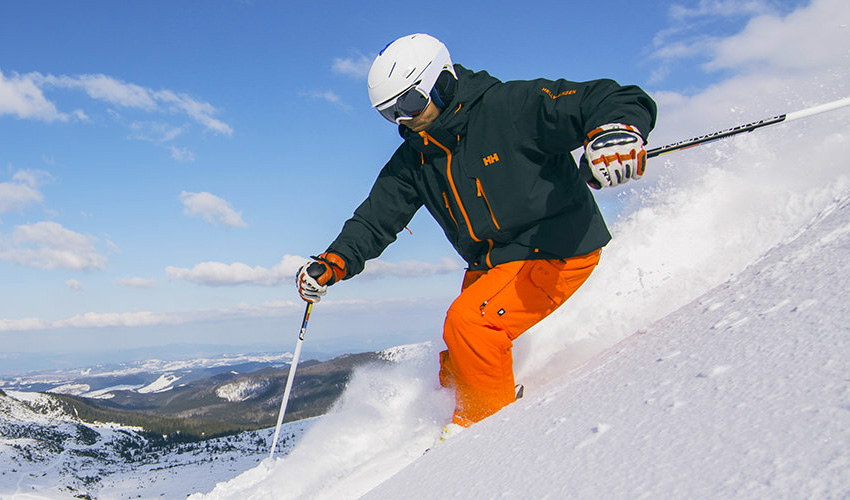Feeling the rush of adrenaline as you glide down a snowy mountain is a feeling like no other. The crisp mountain air, the breathtaking scenery, the sheer joy of movement – it’s an experience that captivates millions. And with 18.46 million Americans taking to the slopes in 2023, it’s clear that skiing’s popularity is only growing.
But before you embark on your snowy adventure, being prepared is important. The right gear can make all the difference between a fantastic experience and a frustrating one. It’s not just about looking good on the slopes; it’s about ensuring your safety, comfort, and performance.
So, let’s explore the essentials that will equip you for an unforgettable downhill ski adventure.
Contents
Skis: Your personalized snow surfboard
Selecting the right skis is key for a great ski experience. They’re your base on the mountain, impacting your balance, control, and how well you ski overall.
In fact, downhill skis come in different lengths, widths, and flex patterns. Beginners usually do well with shorter, wider skis. These provide stability and make it easier to control your movements. You can try longer, narrower skis as you improve for more speed and sharp turns.
When picking skis, consider your height, weight, skill level, and what kind of skiing you like. A helpful expert at a ski shop can suggest the right pair for you. They’ll ensure the skis fit your needs so you feel confident and ready to hit the slopes.
Boots: Where Comfort Meets Control
Ski boots are your direct link to your skis, transferring every movement and adjustment you make. A comfortable, well-fitting boot is critical for a day of enjoyable skiing. It ensures precise control over your skis, which is essential for managing turns and maintaining balance on varied terrain.
When choosing ski boots, prioritize a snug fit that eliminates any unwanted movement or slippage inside the boot. This prevents blisters and discomfort, allowing you to focus on the joy of skiing.
Don’t be afraid to spend time trying on different boots until you find the perfect match for your feet. Remember, a comfortable boot means a more enjoyable and controlled ski experience.
Bindings: The Safety Guardians
Ski bindings may not be the glamorous part of your ski setup, but they are vital for your safety on the slopes. Bindings act as the connection between your boots and your skis. In the event of a fall, they are designed to release your shoes, reducing the risk of severe leg injuries.
Modern bindings are highly sophisticated and can be released at precise angles and forces. This balances performance and safety, ensuring that your skis stay attached during normal skiing but release when needed in a fall.
Having your bindings properly adjusted by a professional is crucial. The settings must be tailored to your boots, skis, and skill level. This ensures the bindings are released appropriately in a fall, protecting you from harm. Don’t overlook this important step – it could be the difference between a minor tumble and a major injury.
Helmet and Goggles: Shield Your Senses
Protecting your head and eyes is paramount on the slopes. A helmet acts as your brain’s guardian, shielding it from potential impacts during falls or collisions. It’s a non-negotiable piece of equipment that every skier should wear regardless of skill level. Look for a helmet that fits snugly and comfortably without obstructing your vision or hearing.
Conversely, goggles safeguard your eyes from harsh elements like wind, snow, and bright sunlight. They provide clear vision, allowing you to go through the slopes safely and confidently. Choose goggles with lenses that match the expected weather conditions. Consider anti-fog coatings to prevent your vision from clouding, ensuring you can see even in challenging conditions.
Remember, a helmet and goggles are not just accessories; they are essential safety gear that can prevent serious injuries. So, always prioritize protecting your head and eyes when you hit the slopes.
Layers: The Key to Comfort
Finally, dressing in layers is your key to staying comfortable on the mountain, no matter the weather. It lets you adjust your clothing to match the changing conditions, ensuring you’re neither hot nor cold.
Start with a base layer that wicks moisture away from your skin, keeping you dry even when you sweat. Next, add a mid-layer for insulation. This traps heat and keeps you warm. Finally, top it off with an outer, waterproof, and breathable layer. This shields you from wind, snow, and rain while allowing perspiration to escape.
Don’t forget about your extremities! Warm socks, gloves or mittens, and a neck gaiter or scarf are essential for staying comfortable. Remember, it’s always better to shed extra layers than to be underdressed and shivering on the slopes.
Final Thoughts
Know that the right gear can transform your ski trip from good to unforgettable. It’s an investment in your safety, comfort, and enjoyment on the slopes. So, gear up, hit the mountain, and embrace the thrill of the ride!


